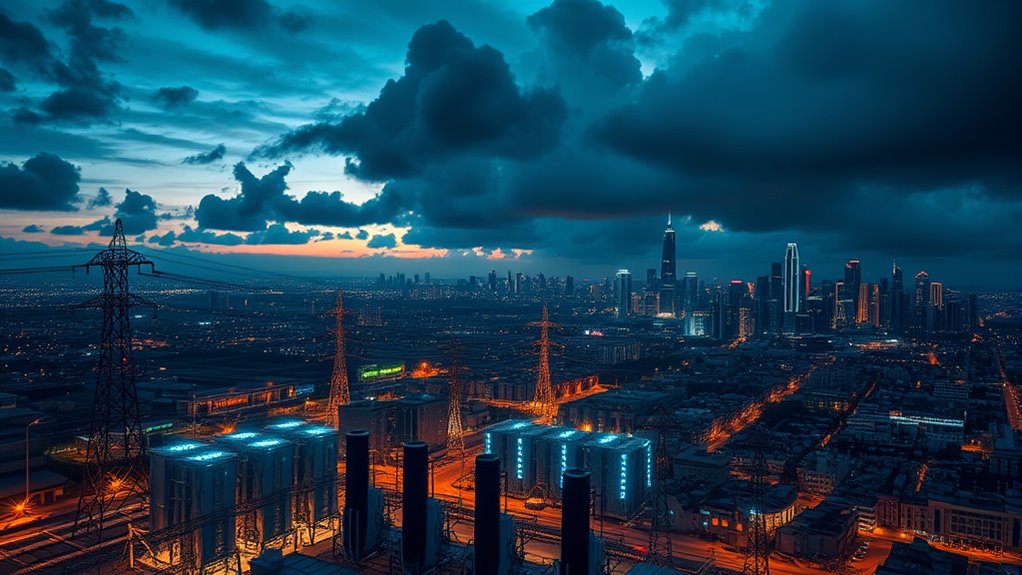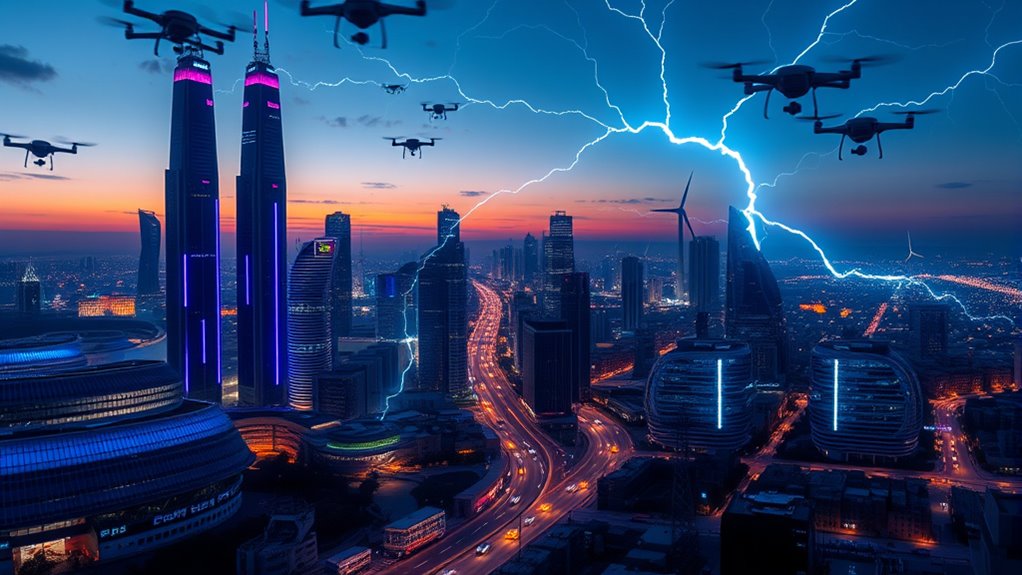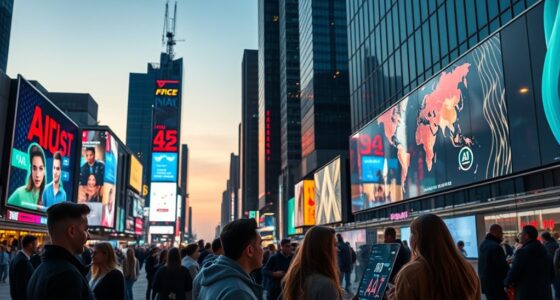As AI technology rapidly advances, it’s likely to strain America’s aging energy infrastructure, causing power shortages and potential grid failures. Data centers supporting AI will demand more electricity, much of which comes from fossil fuels, increasing carbon emissions. This growth puts added pressure on already stressed power grids and infrastructure delays could worsen the problem. If you want to understand how this challenge might unfold and what can be done, there’s more to explore.
Key Takeaways
- AI development significantly increases electricity demand, risking overloads on existing power grids.
- Data centers supporting AI will consume over 6% of US electricity by 2026, straining infrastructure.
- Growing AI workloads rely heavily on fossil fuels, worsening environmental impact and energy sustainability.
- Delays in grid upgrades and renewable integration hinder capacity to meet rising AI energy needs.
- Rapid AI expansion could trigger power shortages and destabilize America’s energy infrastructure.

As AI technology advances rapidly, it’s fueling a surge in data center energy consumption that could strain America’s power grid. The U.S. electricity demand is projected to hit record highs, reaching around 4,179 billion kWh in 2025 and 4,239 billion kWh in 2026. Data centers supporting AI contribute notably to this rise, with commercial electricity use growing up to 5% annually through 2026. Globally, power demand from data centers is expected to increase by 50% by 2027 and potentially 165% by 2030 compared to 2023 levels. By 2027, AI workloads will account for over a quarter of data center energy use, with cloud services making up half, and traditional workloads the remaining 23%. Currently, data centers consume about 4.4% of U.S. electricity, but this share is expected to grow to 6% by 2026.
Training large AI models demands immense energy. Thousands of GPUs and TPUs run continuously for weeks or months, requiring high-powered infrastructure that only major tech companies can afford. This concentration of resource-intensive operations raises environmental concerns, especially since GPUs are typically used for about four years before disposal or repurposing, contributing to electronic waste. While individual AI queries use modest amounts of energy—around 0.34 watt-hours—training and operational demands vastly outweigh these per-query costs. AI training itself consumes a significant portion of the total energy used in AI workflows, amplifying environmental impacts. The rapid deployment of these models accelerates the need for sustainable energy solutions to mitigate environmental damage.
The environmental impact is profound. An estimated 60% of the increased electricity demand from data centers will be met by fossil fuels, releasing roughly 220 million tons of CO2 globally. By 2030, data center energy consumption could surpass Japan’s total electricity use of approximately 945 TWh. These workloads not only intensify carbon footprints but also require substantial water for cooling hardware, potentially matching half of the U.K.’s water consumption by 2027. The lifecycle environmental costs include manufacturing, operation, hardware disposal, and energy generation sources.
This rapid growth puts immense pressure on power infrastructure. Local and national grids risk overloading or losing stability as demand surges. Utilities face challenges managing a shifting energy mix, with increasing renewable integration and decreasing natural gas use, complicating supply reliability. Delays in expanding grid infrastructure and interconnection studies hinder timely responses. Without strategic investments, the growing AI ecosystem could lead to power shortages and grid failures, threatening overall energy security.
Frequently Asked Questions
How Can Energy Companies Prepare for Ai-Induced Demand Surges?
You can prepare for AI-induced demand surges by investing in scalable, high-density infrastructure and upgrading the grid with smart technologies. Prioritize renewable energy integration, streamline regulatory processes, and adopt storage solutions like batteries to balance supply and demand. Use AI-driven tools for demand forecasting, optimize data center efficiency, and collaborate with regulators and stakeholders to guarantee reliable, sustainable energy supply, avoiding outages and supporting continued AI growth.
What Technological Solutions Exist to Prevent Grid Overloads?
You can prevent grid overloads by implementing AI-driven smart grid management, which monitors and adjusts power flow in real time. Predictive analytics forecast demand, helping you anticipate surges. Demand response programs shift loads away from peak times, and grid modernization improves infrastructure resilience. Additionally, integrating distributed energy resources and adopting energy-efficient hardware further reduces overload risks, ensuring a stable, reliable energy supply even during AI-driven demand fluctuations.
How Will AI Impact Renewable Energy Integration?
You’ll love how AI turns chaos into order, making renewable energy integration a breeze. It predicts weather patterns, manages storage, and balances demand faster than you can say “solar panel.” Virtual power plants and smart meters work in harmony, turning scattered renewables into a symphony of sustainable power. So, yes, AI’s got the magic touch, ensuring your green energy dreams don’t crash like a poorly coded app.
Are There Policies to Regulate Ai-Driven Energy Consumption?
Yes, there are policies to regulate AI-driven energy consumption. You’ll see efforts like the Department of Energy AI Act, which promotes AI’s role in grid modernization and mandates reporting on data center energy use. The White House’s AI Action Plan also aims to streamline permits for AI infrastructure and encourage greener tech. These policies target balancing AI growth with energy efficiency, helping you manage and reduce AI’s environmental impact effectively.
What Role Will Consumer Behavior Play in Managing Energy Loads?
Your behavior will be vital in managing energy loads. By shifting your electricity use to off-peak hours, participating in demand response programs, and adopting energy-efficient devices, you help balance the grid. Engaging with smart technology and renewable options further reduces strain. Your awareness about AI’s energy impact encourages smarter choices, driving collective efforts to prevent overloads and guarantee a stable, resilient energy system amidst increasing AI demands.
Conclusion
As you witness the AI revolution unfold, remember that America’s energy infrastructure might struggle to keep pace—like trying to power a spaceship with a candle. If we don’t adapt quickly, the surge of smarter systems could overload our grids, causing blackouts and chaos. It’s a future where, like the dawn of the internet, you’ll wish you’d prepared better. Stay vigilant; the clock’s ticking, and history won’t wait for us to catch up.









